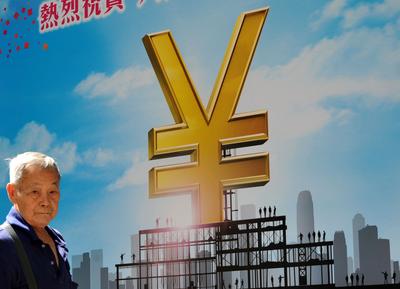The currency is starting to be used to invoice some of China’s international trade, and foreign central banks have been able to hold renminbi since August 2010 — with Malaysia the first to do so.
Some are now claiming that the renminbi could overtake the dollar for the number one slot in the international currency rankings within a decade. The basis of this prediction is, first, the likelihood that the Chinese economy will surpass the US economy in size, and, second, the historical precedent when the dollar overtook the pound sterling as the number one international currency during the period after World War I.
It used to be thought that international currency status was subject to much inertia. Many also posited a long lag between the date when the US economy had passed the UK economy with respect to size (1872, by the criterion of GNP) and the time when the dollar had passed the pound (1946, by the criterion of shares in central banks’ holdings of reserves).
The ‘new view’ is that the lag was in fact rather short: the dollar did not fulfil the prerequisites of an international currency until World War I. After that, internationalisation came quickly. The date when the dollar is said to have come to rival the pound in importance has now been moved back to the mid-1920s. The first point is right. If trade is the measure of size, the US first caught up with the UK during World War I. The US did not even have a permanent central bank until 1913. The other important criteria came soon thereafter: creditor status for the country; the perceived prospects for the currency to remain strong in value; and deep, liquid, open financial markets. The second point seems a matter of whether or not one wants to distinguish between the concept of ‘coming to rival’ or ‘catching up with’ the pound (apparent by the 1920s) versus the phenomenon of definitively ‘pulling ahead’ or ‘displacing’ the pound (evident by 1945). Under either interpretation, the dollar’s initial rise as an international currency was indeed rapid, once the conditions were in place.
The dollar is one of three national currencies to have attained international status during the 20th century. The other two were the yen and the mark, which became major international currencies after the breakup of the Bretton Woods system in 1971-73. (The euro, of course, did so after 1999.) In the early 1990s, both were spoken of as potential rivals to the dollar for the number one slot. It is easy to forget it now, because Japan’s role has diminished since then and the mark has been superseded. In retrospect, the two currencies’ shares in central bank reserves were peaking as the 1990s began.
The current renminbi phenomenon differs in an interesting way from the historical circumstances of these three earlier currencies’ rise. The Chinese government is actively promoting the international use of its currency. Neither Germany nor Japan, nor even the US, did that — at least not at first. In all three cases, export interests — who stood to lose competitiveness if international demand for the currency were to rise — were much stronger than the financial sector, which might have supported internationalisation. One would expect the same fears of a stronger currency and its effects on manufacturing exports to dominate calculations inChina.
In the case of the mark and the yen after 1973, internationalisation came despite the reluctance of the German and Japanese governments. In the case of the US after 1914, a tiny elite promoted internationalisation of the dollar despite the indifference or hostility to such a project in the nation at large. These individuals, led by Benjamin Strong — the first president of the New York Fed — were the same ones who conspired in 1910 to establish the Federal Reserve in the first place.
It is not yet clear that China’s new enthusiasm for internationalising its currency includes a willingness to end financial repression in the domestic financial system, remove cross-border capital controls and allow the renminbi to appreciate, thus helping to shift the economy away from its export-dependence. Perhaps a small elite will be able to accomplish these things, in the way that Strong did a century earlier. But so far the government is only promoting international use of the renminbi offshore, walled off from the domestic financial system. That will not be enough to get the job done.
Jeffrey Frankel is the Harpel Professor of Capital Formation and Growth at the Kennedy School of Government, Harvard University, and is the Director of Program in International Finance and Macroeconomics at the National Bureau of Economic Research, USA.
A version of this article first appeared here on the Perspectives page of Japan’s Research Institute of Economy, Trade & Industry. It summarises the argument in ‘Historical Precedents for the Internationalization of the RMB’, a paper written for a workshop directed by Sebastian Mallaby, organised by the Council on Foreign Relations and the China Development Research Foundation.


This article assumes that internationalization is a given goal, but China probably sees internationalization as something with pros and cons. For the foreseeable future the concerns will be mostly domestic and not international.